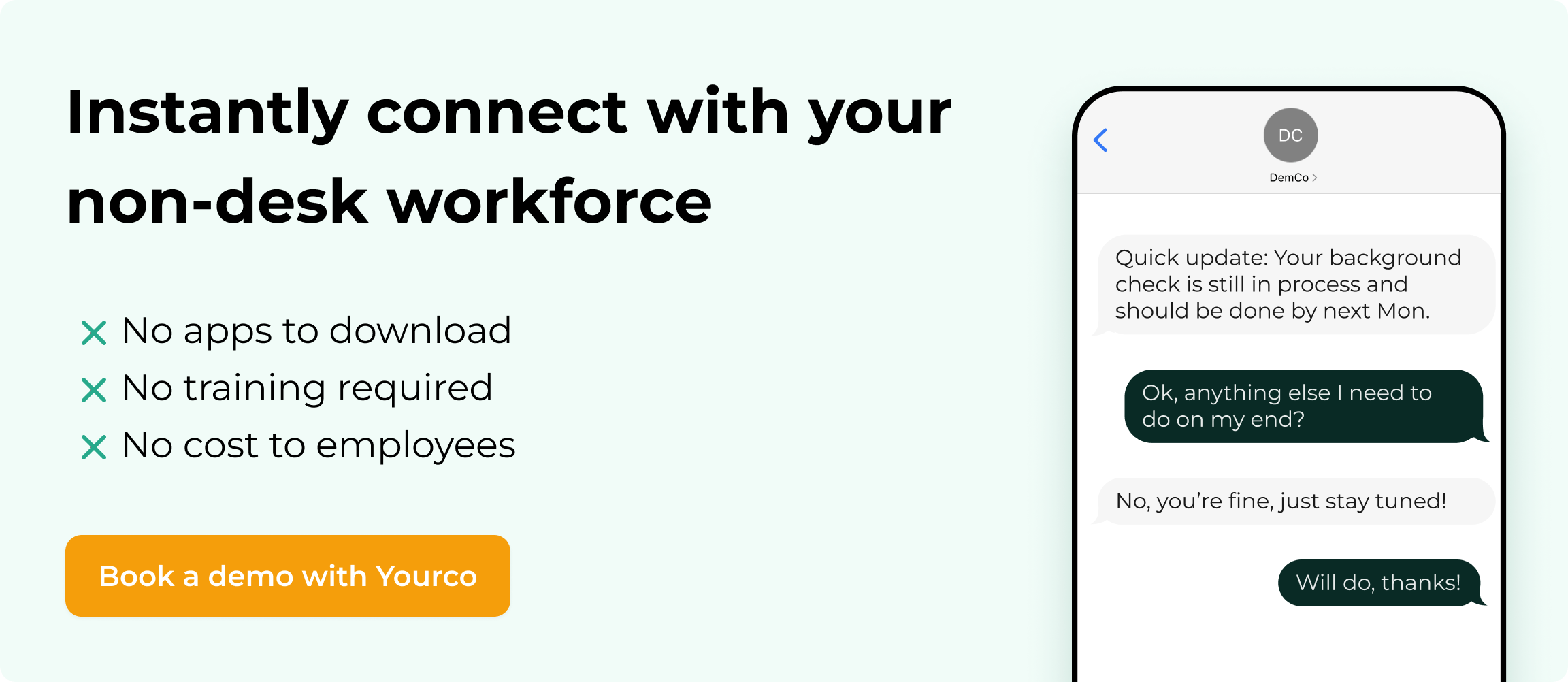Efficient Safety Alert Templates for Immediate Workforce Communication


When workplace emergencies happen, quick and clear communication can mean the difference between a minor incident and a serious disaster. Too many organizations still rely on outdated methods that slow down responses or create confusion when every second counts. We know how frustrating it feels when your safety message doesn't reach everyone who needs it.
Companies need simple tools that quickly deliver clear, actionable safety information across their entire workforce. Effective safety alert templates fill this gap, helping businesses respond fast to hazards, stay compliant with changing regulations, and build a workplace where safety feels natural.
This article shows you the must-have elements and best practices for designing safety alert templates that get your message to everyone immediately when it matters most.
Importance of Safety Alert Templates in Workplace Safety
Safety alert templates help you quickly tell employees about workplace hazards, incidents, and emergency procedures. They come in different forms:
- Incident-based Alerts - Tell employees what happened and what they need to do
- Preventive Alerts - Warn about potential risks like seasonal hazards or equipment dangers
- Emergency Response Templates - Give clear instructions during crises
These templates help you send the same clear message to everyone, improving response times and reducing confusion. Many regulatory bodies require specific safety communications, making these templates necessary for compliance.
Good alerts balance being thorough with being brief—they give enough information for people to take the right action without overwhelming details. This balance matters most during emergencies when quick action saves lives.
Regular safety communications drive workplace safety improvements by keeping safety top-of-mind for employees. They encourage vigilance and help people spot hazards before they become problems. They also help organizations meet regulatory requirements for sharing specific safety information.
Key Elements of an Effective Safety Alert Template
A strong safety alert template gets your message across quickly and clearly when it matters most.
Attention-Grabbing Title and Clear Identification
Your safety alert title should grab attention immediately and tell people what's happening. Make it short but specific enough to show urgency and what kind of situation you're dealing with. Skip vague headings like "Safety Notice" and use specifics: "Immediate Action Required: Chemical Spill in Lab B."
Include these details: exact worksite location, date and time of discovery, how serious the situation is, and who approved the alert plus whom to contact.
The title creates the first impression of your alert and directly affects whether employees will pay attention. Color-coding severity levels helps people immediately understand how urgent things are—red for immediate dangers, yellow for cautions, green for informational notices. This visual system works well on digital platforms and printed materials, giving instant context before anyone reads a word.
A unique tracking number for each alert helps with documentation, follow-up, and reference in future communications or investigations. This numbering system also helps employees when they discuss specific safety issues.
Concise Incident or Hazard Description
Your incident or hazard log description should tell people what happened or what hazard was found, explain the cause if you know it, describe any injuries or damages, use simple language everyone understands, and state how urgent this is upfront.
Rather than saying "A safety incident occurred," give specifics: "A forklift collision in Warehouse C resulted in minor injuries to two employees and damage to inventory shelving."
The hazard description should paint a clear picture without technical jargon that might confuse team members. Include details about conditions that contributed to the incident when relevant, such as "wet floor due to roof leak" rather than simply "slip hazard." This context helps everyone understand exactly what happened and why.
If the incident involves equipment, include model numbers and specific identifiers so people know exactly which machines might have similar risks. For chemical exposures or materials incidents, note exact substances involved and whether contamination might have spread beyond the immediate area.
Immediate Action Items
This section tells people exactly what they need to do right now: control measures to put in place, ways to prevent this from happening again, new protocols or safety measures, and training requirements or procedure changes.
Be specific. "All forklift operators must attend a mandatory safety refresher course this week" works better than "Improve forklift safety."
Action items should follow a logical order when multiple steps are needed. Number them clearly and show which departments or roles handle each action. This accountability prevents confusion about who should take which steps.
Include both immediate and longer-term actions when appropriate, clearly distinguishing between the two. For immediate actions, give absolute deadlines: "Complete by 5 PM today" rather than "Complete as soon as possible." This clarity creates urgency and allows for proper follow-up.
For serious incidents, consider including a compliance verification step where supervisors must confirm that required actions have been completed and submit documentation.
Contact Information and Resources
Give clear contact details for questions or additional information: name and title of the safety officer in charge, phone number and email for immediate contact, and links to relevant safety procedures or documentation.
Consider including multiple contacts for different aspects of the response—one for procedural questions, another for medical concerns, and perhaps another for media inquiries if the incident might attract public attention. This approach helps employees get accurate information from the right expert.
Include hours of availability for each contact, especially for organizations with multiple shifts. Second or third shift workers need to know whom to contact during their working hours. Provide alternatives for after-hours emergencies or questions that can't wait until regular business hours.
For digital alerts, embed hyperlinks to relevant resources such as safety data sheets, evacuation maps, or detailed procedures. These resources save valuable time during emergencies and help everyone follow correct protocols rather than relying on memory.
Standardization and Compliance Elements
Make sure your safety alert template stays consistent and meets regulatory requirements: use the same formatting for all safety alerts, include your organization's branding for easy recognition, add any mandatory language required by regulators, and assign a unique identifier to each alert.
Different industries focus on certain elements based on their specific risks and regulations. Healthcare might emphasize patient safety and infection control, while manufacturing focuses on equipment warnings and PPE requirements. Using regulatory compliance tips helps you align your safety communications with industry standards.
Standardization extends to visual elements as well. Using consistent icons, warning symbols, and color schemes across all safety communications builds visual literacy among your workforce. When employees immediately recognize the meaning of standardized visual elements, they process the information more quickly and accurately.
Consider including a section for "Lessons Learned" on follow-up communications about resolved incidents. This knowledge sharing shows your organization's commitment to continuous improvement and gives practical examples of how safety procedures prevent harm when properly followed.
Creating a Safety Alert Template
A well-designed safety alert template helps you quickly share information during emergencies.
Framework Design
- Make Your Title Count: Start with a clear, direct title that shows the nature and urgency of the alert. Examples: "HAZMAT ALERT" or "EMERGENCY EVACUATION NOTICE."
- Include Essential Identification Details:
- Specific location of the incident or hazard
- Date and time of the alert
- Severity classification (e.g., high, medium, low)
- Authorization information (who issued the alert)
- Describe the Incident Clearly: Give a brief but detailed account of what happened or what hazard exists. Use plain language that everyone can understand.
- Specify Action Steps: Clearly state what employees need to do in response. Bullet points make these steps easy to read quickly.
- Add Visual Support: Include relevant images, diagrams, or warning symbols to boost understanding and memory retention.
- Provide Contact Resources: Tell people where to get more information or who to contact with questions.
- Build in Acknowledgment: Add a way for employees to confirm they've received and understood the alert.
Strike a balance between being thorough and being brief. Your template should cover all necessary information but remain short enough to be quickly understood during an emergency.
To help you implement this quickly, we've created a Safety Alert Template you can customize for your team.
→ Download the free Safety Alert Template (PDF) and start improving your safety communication today.
Customization Tips for Different Industries
Keep your format consistent, but adjust content for your specific industry:
Manufacturing
Include equipment-specific warnings, shutdown procedures, and PPE requirements. Address maintenance schedules and lock-out/tag-out procedures for machinery involved in incidents. Note any contamination risks from industrial processes or materials.
Also include information about specialized equipment needed for response, such as chemical spill kits or fire suppression systems. Specify zones that might need evacuation or containment based on the facility layout and workflow patterns.
Healthcare
Address patient safety implications, infection control considerations, and medical equipment alerts. Include information about potential impacts on patient care areas and continuity of care during safety events. Consider isolation requirements for infectious disease concerns.
Also note any medication safety issues including look-alike/sound-alike risks. Provide guidance for communicating with patients and families about safety incidents when appropriate. Include any reporting requirements specific to healthcare regulatory agencies.
Hospitality
Highlight safety alerts around guest interactions, housekeeping risks, and kitchen hazards. Clearly communicate procedures for incidents involving guests, such as evacuations, fire safety, or illness outbreaks. Include hygiene protocols for food preparation and handling, especially to prevent cross-contamination or foodborne illness incidents.
Address security measures, such as response procedures for theft, unauthorized access, or disturbances. Specify protocols for reporting and managing incidents discretely, ensuring minimal disruption to guest experience. Include clear guidance for managing high-traffic areas like lobby entrances, dining areas, and event spaces during emergencies. Provide specialized contact information for guest-facing roles, including concierge, front desk, and security teams, to streamline immediate response actions.
Construction
Emphasize structural hazards, equipment failures, and environmental concerns specific to work sites. Detail temporary evacuation routes that accommodate ongoing construction activities.
Don't forget to include information about scaffolding safety, excavation risks, or crane operations affected by safety incidents. Specify subcontractor notification requirements for shared work zones. Address weather-related concerns that might intensify existing hazards or create new ones.
Best Practices for Distributing Safety Alerts
Getting safety alerts to everyone who needs them takes thoughtful planning.
Channels for Distribution
To maximize your safety alerts' impact, use multiple communication channels. Using various methods helps messages reach all employees, especially non-desk workers. Here are some communication tips for deskless workers to help you reach everyone effectively:
- Digital Signage: Place displays in common areas to reach employees who move throughout your facility
- SMS Messaging: Use text alerts for urgent safety information, creating a straightforward notification system to reach employees quickly and efficiently
- Pop-ups and Screen Overlays: Display visual alerts on work computers
- Physical Signage: Maintain bulletin boards and posters in high-traffic areas
- Public Address Systems: Use audio announcements for immediate alerts
When selecting distribution channels, also consider how different worker groups access information throughout their day. Factory floor workers might benefit from large digital displays visible from work stations, while drivers need mobile solutions that reach them on the road. Healthcare workers might need wearable alert devices that don't disrupt patient care.
Among all these channels, SMS messaging stands out as particularly powerful for reaching any worker who doesn't work at a desk. These 'non-desk workers' often lack regular access to emails or workplace apps. Yourco, an SMS-based communication platform, shows this effectiveness with a 98% open rate and an average response time of just 90 seconds. Unlike traditional communication methods, SMS requires no downloads or internet access, so workers receive safety alerts immediately without technical barriers.
Yourco's two-way messaging capabilities allow employees to instantly respond, report hazards, and even send timestamped photos or videos directly from their phones—making it a comprehensive solution for rapid incident reporting and proactive safety management.
The most effective safety communication systems layer multiple channels simultaneously. This redundancy makes sure people receive messages even if one system fails. During emergencies, this approach becomes particularly valuable—a message missed on physical signage might be read in text messages.
Timing and Frequency Considerations
Timing matters, especially for organizations with employees across multiple time zones. Schedule messages based on local working hours to prevent message fatigue and make sure people actually see them.
For ongoing safety communications:
- Send daily safety messages to build a sustained safety culture
- Provide regular safety updates to help make safe practices part of daily routines
- Keep messaging consistent to reinforce safety awareness and develop prevention-focused thinking
Message timing should account for workflow patterns and shift changes. Alerts sent during shift handovers might be missed as workers transition responsibilities. Similarly, alerts during busy production periods might not receive proper attention. Schedule non-emergency communications during natural workflow breaks when possible.
The frequency of communications needs careful balance. Too few messages suggest safety isn't a priority, while too many can lead to alert fatigue where employees start ignoring all communications. A structured communication calendar helps maintain appropriate frequency without overwhelming your audience.
Send Safety Alerts That Actually Get Read
Well-crafted safety alert templates with attention-grabbing titles, clear incident descriptions, and specific action items help you communicate fast and consistently during emergencies.
Regular template updates also keep pace with new workplace hazards and changing regulations. Great safety communication needs distribution strategies that reach everyone—including those without desks or computers. By engaging deskless workers, you make sure that critical safety information reaches every member of your team.
Yourco stands out as the #1 SMS-based employee app built for the non-desk workforce. The platform sends safety alerts via text message—reaching 98% of employees within minutes, regardless of location. Unlike email systems, Yourco connects directly with employees on their personal phones without requiring downloads or technical knowledge.
The platform segments communications by department, location, or shift, tracks who has read each alert, and enables automated safety reminders. This capability proves invaluable during emergencies for coordinating responses and confirming everyone's safety.
Try Yourco for free today or schedule a demo and see the difference the right workplace communication solution can make in your company.
Frequently Asked Questions
What to do if employees aren't responding to critical safety alerts?
Start by checking that your alert reached everyone—some communication methods have low delivery rates, so it's advisable to use SMS, which has a 98% open rate. If delivery isn't the issue, follow up with supervisors to confirm the message was received and understood. For emergency situations, have a backup communication method ready. Consider whether your alerts are too long, unclear, or sent at poor timing. Sometimes a simple "Reply YES to confirm you received this safety alert" can help you identify who needs additional follow-up.
How can we ensure non-English speaking employees understand safety alerts?
Language barriers in safety communication can be dangerous. Use simple, clear language and avoid technical jargon whenever possible. Consider providing alerts in the primary languages spoken by your workforce. Visual aids like safety symbols or diagrams can help transcend language barriers. Yourco offers automatic translation features that can instantly convert your safety messages into 135+ languages and dialects, ensuring every employee gets critical information in a language they understand.
What's the difference between emergency and non-emergency safety alert content?
Emergency alerts should be immediate and action-focused: "Chemical spill in Building C. Evacuate immediately via north exit." Include only essential information—what happened, where, and what to do right now. Non-emergency alerts can provide more context and prevention tips: "Yesterday's slip incident reminds us to report wet floors immediately. Call ext. 123 for spill cleanup." Emergency alerts demand instant action, while routine alerts build ongoing safety awareness and culture.
How can we measure if our safety alert system is actually working?
Track both communication metrics and safety outcomes. For communication: monitor delivery rates, response times, and employee acknowledgments. For safety impact: compare incident rates before and after implementing your alert system, measure how quickly safety issues get reported, and survey employees about safety awareness. The most telling metric is whether employees feel informed and empowered to act on safety concerns. Regular feedback sessions can reveal gaps in your communication that numbers alone might miss.



